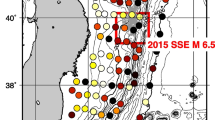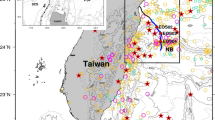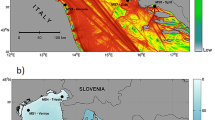Abstract
We analyze data retrieved from an ocean floor pressure sensor continuously operated for 48 days in the Mentawai Strait during the Spring of 2016, as part of Project Hazard SEES. Initial processing through systematic spectrogram analysis has identified ten distant earthquakes recorded through the variation of pressure accompanying the passage of seismic waves on the bottom of the ocean. The analysis of the corresponding wavetrains allows the recovery of the standard magnitude \(M_s\) of seven of the events (two more being intermediate depth, and the tenth antipodal) with a residual not exceeding 0.3 logarithmic units. We also show that the classical energy-to-moment ratio computation can be successfully adapted by defining a response function of the pressure sensor to teleseismic P waves. In addition, six local earthquakes, occurring at distances of 58–670 km from the sensor, but with moment magnitudes less than 5.7, were also recorded. We show that an estimate of the seismic energy radiated by these events can be obtained from a simple integration of the square of the pressure signal. Thus our results indicate that meaningful quantitative estimates of the source characteristics of both teleseismic and regional events can be obtained through robust methods based on single-station pressure recordings on the ocean floor.













Similar content being viewed by others
References
Boatwright, J., & Choy, G. L. (1986). Teleseismic estimates of the energy radiated by shallow earthquakes. Journal of Geophysical Research, 91, 2095–2112.
Borrero, J. C., Sieh, K., Chlieh, M., & Synolakis, C. E. (2006). Tsunami inundation modeling for Western Sumatra. Proceedings of the National Academy of Sciences B, 103, 19673–19677.
Borrero, J. C., Weiss, R., Okal, E. A., Hidayat, R., Arcas, S., & Titov, D. V. V. (2009). The tsunami of 2007 September 12, Bengkulu Province, Sumatra, Indonesia: Post-tsunami survey and numerical modeling. Geophysical Journal International, 178, 180–194.
Cohen, L. (1989). Time-frequency distributions—a review. Proceedings of the Institute of Electrical and Electronic Engineering, 77, 941–981.
Dziewonski, A. M., Chou, T. A., & Woodhouse, J. H. (1981). Determination of earthquake source parameters from waveform data for studies of global and regional seismicity. Journal of Geophysical Research, 86, 2825–2852.
Ebeling, C. W., & Okal, E. A. (2012). An extension of the \(E/M_0\) tsunami earthquake discriminant \(\Theta\) to regional distances. Geophysical Journal International, 190, 1640–1656.
Ekström, G., Nettles, M., & Dziewoński, A. M. (2012). The global CMT project, 2004–2010: Centroid moment tensors for 13,107 earthquakes. Physics of the Earth and Planetary Interiors, 200, 1–9.
Geller, R. J. (1976). Scaling relations for earthquake source parameters and magnitudes. Bulletin of the Seismological Society of America, 66, 1501–1523.
Haskell, N. A. (1953). The dispersion of surface waves on multilayered media. Bulletin of the Seismological Society of America, 43, 17–34.
Meining, C., Stalin, S., Nakamura, A.I., González, F.I., & Milburn, H.B. (2005). In Technology developments in real-time tsunami measuring, monitoring and forecasting, Proceedings of the OCEANS 2005 MTS/IEEE Conference, pp. 1673–1679, Washington, D.C.
Mendiguren, J. (1971). Focal mechanism of a shock in the middle of the Nazca plate. Journal of Geophysical Research, 76, 3861–3879.
Mungov, G., Eblé, M., & Bouchard, R. (2013). DART tsunameter retrospective and real-time data: A reflection on 10 years of processing in support of tsunami research and operations. Pure and Applied Geophysics, 170, 1369–1384.
Natawidjaja, D. H., Sieh, K., Chlieh, M., Galetzka, J., Suwagardi, B. W., Cheng, H., et al. (2006). Source parameters of the great Sumatran megathrust earthquakes of 1797 and 1833 inferred from coral microatolls. Journal of Geophysical Research, B6, B06403. (37 pp).
Newman, A. V., & Okal, E. A. (1998). Teleseismic estimates of radiated seismic energy: The \(E/M_0\) discriminant for tsunami earthquakes. Journal of Geophysical Research, 103, 26885–26898.
Okal, E. A. (1992). A student’s guide to teleseismic body-wave amplitudes. Seismological Research Letters, 63, 169–180.
Okal, E. A. (2019). Energy and magnitude: A historical perspective. Pure and Applied Geophysics, 176, 3815–3849.
Okal, E. A., & Talandier, J. (1989). \(M_m\): A variable period mantle magnitude. Journal of Geophysical Research, 94, 4169–4193.
Paros, J., Migliacio, P., Schaad, T., Meining, C., Spillane, M., Stalin, S., & Chadwick, W. (2012). Nano-resolution technology demonstrates promise for improved local tsunami warnings on the MARS project. In Proceedings of the OCEANS 2012 IEEE Conference, 12, 6 pp., Hampton Roads, Virginia.
Saloor, N., & Okal, E. A. (2018). Extension of the energy-to-moment parameter \(\Theta\) to intermediate and deep earthquakes. Physics of the Earth and Planetary Interiors, 274, 37–48.
Sella, G. F., Dixon, T. H., & Mao, A. (2002). REVEL: A model for Recent plate velocities from space geodesy. Journal of Geophysical Research, 107(B4), ETG-11. (32 pp).
Vaněk, J., Zátopek, A., Kárnik, V., Kondorskaya, N. V., Riznichenko, Yu. V., Savarenskiĭ, E. F., et al. (1962). Standardizatsya shkaly magnitud. Izvestiya Akademii Nauk SSSR, Seria Geofizicheskaya, 2, 153–158 (in Russian; English translation, Bulletin of the USSR Academy of Sciences, Geophysics Series, 2, 108–111).
Wessel, P., & Smith, W. H. F. (1991). Free software helps map and display data. Eos, Transactions of the American Geophysical Union, 72, 441 and 445–446.
Zachariasen, J., Sieh, K., Taylor, F. W., Edwards, R. L., & Hantoro, W. S. (1999). Submergence and uplift associated with the giant 1833 Sumatran subduction earthquake: Evidence from coral microatolls. Journal of Geophysical Research, 104, 895–919.
Acknowledgements
This research was supported by the Hazards NEES program of the National Science Foundation under Grant Number OCE-1331463 to the University of Pittsburgh. We thank Louise Comfort for her leadership in this project. The authors would like to acknowledge the invaluable help of Prof. Febrin Anas Ismail of Andalas University (Padang), Iyan Turyana of the BPPT (Jakarta) and the Captain and crew of the KN MUCI (Padang). The paper was significantly improved by the comments of two anonymous reviewers. Some figures were plotted using the GMT software (Wessel and Smith 1991).
Author information
Authors and Affiliations
Corresponding author
Additional information
Publisher's Note
Springer Nature remains neutral with regard to jurisdictional claims in published maps and institutional affiliations.
Rights and permissions
About this article
Cite this article
Freitag, L., Okal, E.A. Preliminary Results from a Prototype Ocean-Bottom Pressure Sensor Deployed in the Mentawai Channel, Central Sumatra, Indonesia. Pure Appl. Geophys. 177, 5119–5131 (2020). https://doi.org/10.1007/s00024-020-02561-6
Received:
Revised:
Accepted:
Published:
Issue Date:
DOI: https://doi.org/10.1007/s00024-020-02561-6




